Comprehensive Evaluation of Different Oat Varieties in Semi-Arid Areas of Gansu Province
Abstract
1. Introduction
2. Materials and Methods
2.1. Test Site Overview
2.2. Testing Material
2.3. Experimental Design
2.4. Determination of Production Traits of Oats
2.4.1. Investigation of Growth Period
2.4.2. Agronomic Traits
2.4.3. Yield Traits
2.4.4. Determination of Nutritional Quality of Oats at Filling Stage
2.4.5. Investigation of Pests and Diseases in Oat Filling Stage
2.4.6. Aphid Pest Investigation in Oats During Filling Stage
2.5. Statistical Analysis of Data
3. Results
3.1. Growth Period
3.2. Agronomic Characters
3.3. Hay Yield Analysis of Different Oat Varieties
3.4. Grain Yield
3.5. Analysis of Nutritional Quality of Different Oat Varieties
3.6. Disease Analysis
3.7. Analysis of Aphid Resistance of Different Oat Varieties
3.8. Correlation Analysis of Traits
3.9. Comprehensive Index, Weight, Membership Function Value, D Value, and Comprehensive Evaluation of 10 Oat Varieties
4. Discussion
4.1. Growth Period and Yield Traits of Different Oat Varieties
4.2. Nutritional Quality
4.3. Diseases and Pests of Different Oat Varieties
4.4. Comprehensive Evaluation Analysis
5. Conclusions
Author Contributions
Funding
Data Availability Statement
Acknowledgments
Conflicts of Interest
References
- Ki-Seung, K.; Tinker, N.A.; Newell, M.A. Improvement of Oat as a Winter Forage Crop in the Southern United States. Crop Sci. 2014, 54, 1336–1346. [Google Scholar] [CrossRef]
- Mccartney, D.; Fraser, J.; Ohama, A. Annual cool season crops for grazing by beef cattle. A Canadian review. Can. J. Anim. Sci. 2008, 88, 517–533. [Google Scholar] [CrossRef]
- Carr, P.M.; Horsley, R.D.; Poland, W.W. Barley, Oat, and Cereal–Pea Mixtures as Dryland Forages in the Northern Great Plains. Agron. J. 2004, 96, 677–684. [Google Scholar] [CrossRef]
- Kristensen, M.; Bügel, S. A diet rich in oat bran improves blood lipids and hemostatic factors, and reduces apparent energy digestibility in young healthy volunteers. Eur. J. Clin. Nutr. 2011, 65, 1053–1058. [Google Scholar] [CrossRef] [PubMed]
- Lu, Y.; Wang, R.; Cai, Z. Climatic change and influence in arid and semi-arid area of China. J. Arid. Land Resour. Environ. 2009, 19, 1651–1662. [Google Scholar] [CrossRef]
- Peel, M. Alfalfa and Forage Kochia Improve Nutritive Value of Semiarid Rangelands. Forage Grazinglands 2013, 11, 1–10. [Google Scholar] [CrossRef]
- Zhang, J.; Nie, X.; Zhao, G. First Report of Leaf Spot Caused by Alternaria brassicae on Avena sativa in China. Plant Dis. 2021, 105, 3750. [Google Scholar] [CrossRef] [PubMed]
- Wang, P.; Ma, Y.; Gan, H.; Gu, X. Evaluation of production performance and feeding value of 14 forage oats in the northern foot of Qilian Mountains. Livest. Vet. J. 2022, 41, 95–98+100. [Google Scholar]
- Mu, P.; Zhao, G.; Chai, J. Analysis of oat production performance and adaptability in different ecological regions of Gansu Province based on GGE-Biplot. Chin. J. Ecol. Agric. 2015, 23, 705–712. [Google Scholar]
- Martinez, M.F.; Arelovich, H.M.; Wehrhahne, L.N. Grain yield, nutrient content and lipid profile of oat genotypes grown in a semiarid environment. Field Crops Res. 2010, 116, 92–100. [Google Scholar] [CrossRef]
- Wang, G.; Xu, H.; Zhao, H.; Wu, Y.; Gao, X.; Chai, Z.; Liang, Y.; Zhang, X.; Zheng, R.; Yang, Q.; et al. Screening Optimal Oat Varieties for Cultivation in Arid Areas in China: A Comprehensive Evaluation of Agronomic Traits. Agronomy 2023, 13, 2266. [Google Scholar] [CrossRef]
- Macray, J.E.; Montgomery, D.R. Trends in soil organic matter and topsoil thickness under regenerative practices at the University of Washington student farm. PeerJ 2023, 11, e16336. [Google Scholar] [CrossRef] [PubMed] [PubMed Central]
- Soon, Y.K.; Abboud, S. A comparison of some methods for soil organic carbon determination. Commun. Soil Sci. Plant Anal. 1991, 22, 943–954. [Google Scholar] [CrossRef]
- Jalali, M.; Jalali, M.; Beygi, M.; Salehi, Z.; Antoniadis, V. Available and total phosphorus background levels in soils: A calcareous and semi-arid region. Environ. Monit. Assess. 2023, 195, 600. [Google Scholar] [CrossRef] [PubMed]
- Arunrat, N.; Sereenonchai, S.; Hatano, R. Effects of fire on soil organic carbon, soil total nitrogen, and soil properties under rotational shifting cultivation in northern Thailand. J. Environ. Manag. 2022, 302, 113978. [Google Scholar] [CrossRef] [PubMed]
- Mondal, R.; Mistri, B. Determination of Soil Quality Index of agricultural land adjacent to industrial sites of Jamuria C.D.Block, Paschim Bardhaman District, West Bengal. Environ. Monit Assess 2023, 195, 1536. [Google Scholar] [CrossRef] [PubMed]
- Kelman, W.M.; Dove, H. Growth and phenology of winter wheat and oats in a dual-purpose management system. Crop Pasture Sci. 2009, 60, 921–932. [Google Scholar] [CrossRef]
- Van Wychen, L.R.; Maxwell, B.D.; Bussan, A.J. Wild oat (Avena fatua) habitat and water use in cereal grain cropping systems. Weed Sci. 2004, 52, 352–358. [Google Scholar] [CrossRef]
- Aydin, N.; Mut, Z.; Mut, H. Effect of Autumn and Spring Sowing Dates on Hay Yield and Quality of Oat (Avena sativa L.) Genotypes. J. Anim. Vet. Adv. 2012, 9, 1539–1545. [Google Scholar] [CrossRef]
- Grise, M.M.; Cecato, U.; de Moraes, A.; Canto, M.W.D.; Martins, E.N.; Pelissari, A.; Mira, R.T. Evaluation of chemical composition and in vitro digestibility of mixture of oat IAPAR 61 (Avena strigosa Schreb cv IAPAR 61) +field pea (Pisum arvense L.) under grazing in different sward heights. R. Bras. Zootec. 2001, 30, 659–665. [Google Scholar] [CrossRef]
- Bicsak, R.C.; Collaborators. Comparison of Kjeldahl Method for Determination of Crude Protein in Cereal Grains and Oilseeds with Generic Combustion Method: Collaborative Study. J. Aoac. Int. 1993, 76, 780–786. [Google Scholar] [CrossRef]
- Cherney, D.J.R.; Mertens, D.R.; Moore, J.E. Morphology, fiber composition and mean particle diameter relationships in ground barley and oat forages at different ages. Anim. Feed Sci. Technol. 1990, 31, 65–78. [Google Scholar] [CrossRef]
- Manthey, F.A.; Hareland, G.A.; Huseby, D.J. Soluble and Insoluble Dietary Fiber Content and Composition in Oat. Cereal Chem. 1999, 76, 417420. [Google Scholar] [CrossRef]
- Wang, R.-L.; Wu, J.-Y.; Liu, H.-J. Comparative study on production performance and nutritional quality of ten oat varieties in Inner Mongolia. Feed. Res. 2023, 46, 128. [Google Scholar] [CrossRef]
- Admassu-Yimer, B.; Klos, K.E.; Griffiths, I.; Cowan, A.; Howarth, C. Mapping of Crown Rust (Puccinia coronata f. sp. avenae) Resistance Gene Pc54 and a Novel Quantitative Trait Locus Effective Against Powdery Mildew (Blumeria graminis f. sp. avenae) in the Oat (Avena sativa) Line Pc54. Phytopathology 2022, 112, 1316–1322. [Google Scholar] [CrossRef] [PubMed]
- Zhang, Z.; Lin, Z.; Xin, Z. Research progress in BYDV resistance genes derived from wheat and its wild relatives. J. Genet. Genomics. 2009, 36, 567–573. [Google Scholar] [CrossRef] [PubMed]
- Jeong, M.H.; Choi, E.D.; Park, S.Y. First Report of Brown Leaf Spot Caused by Epicoccum tobaicum on Oat (Avena sativa) in Korea. Plant Dis. 2022, 107, 2255. [Google Scholar] [CrossRef] [PubMed]
- Weiss, W.P. Macromineral digestion by lactating dairy cows: Factors affecting digestibility of magnesium. J. Dairy Sci. 2004, 87, 2167–2171. [Google Scholar] [CrossRef]
- Forbes, A.R. Aphid Populations and Their Damage to Oats in British Columbia. Can. J. Plant Sci. 1962, 42, 660–666. [Google Scholar] [CrossRef]
- Lauriault, L.M.; Kirksey, R.E. Yield and Nutritive Value of Irrigated Winter Cereal Forage Grass–Legume Intercrops in the Southern High Plains, USA. Agron. J. 2004, 96, 352–358. [Google Scholar] [CrossRef]
- Morris, C.A.; Deochand, N.; Peterson, S.M. Using Microsoft Excel® to Build a Customized Partial-Interval Data Collection System. Behav. Anal. Pract. 2018, 11, 504–516. [Google Scholar] [CrossRef] [PubMed] [PubMed Central]
- Loffing, F. Raw Data Visualization for Common Factorial Designs Using SPSS: A Syntax Collection and Tutorial. Front. Psychol. 2022, 13, 808469. [Google Scholar] [CrossRef] [PubMed] [PubMed Central]
- Meng, W.Y.; Li, J.Q.; Xu, G.C.; Guo, J.W.; Zhao, W. Numerical Simulation and Experimental Research of Icicles under The Single Point of Blasting in the Yellow River. Appl. Mech. Mater. 2014, 501–504, 2020–2025. [Google Scholar] [CrossRef]
- Ghafoor, R.; Akram, N.A.; Rashid, M.; Ashraf, M.; Iqbal, M.; Lixin, Z. Exogenously applied proline induced changes in key anatomical features and physio-biochemical attributes in water stressed oat (Avena sativa L.) plants. Physiol. Mol. Biol. Plants 2019, 25, 1121–1135. [Google Scholar] [CrossRef] [PubMed] [PubMed Central]
- Rahetlah, V.B.; Randrianaivoarivony, J.M.; Razafimpamoa, L.H. Effects of Seeding Rates on Forage Yield and Quality of Oat (Avena sativa L.) Vetch (Vicia sativa L.) Mixtures Under Irrigated Conditions of Madagascar. Afr. J. Food Agric. Nutr. Dev. 2010, 10, 4254–4267. [Google Scholar] [CrossRef]
- Coblentz, W.K.; Bertram, M.G.; Martin, N.P. Planting Date Effects on Fall Forage Production of Oat Cultivars in Wisconsin. Agron. J. 2011, 103, 145–155. [Google Scholar] [CrossRef]
- Jing, F.; Ren, S.; Bian, F. Adaptability evaluation and screening of 16 oat varieties in Longzhong area of Gansu. Chin. J. Grassl. 2023, 45, 68–76. [Google Scholar]
- Peterson, D.M.; Wesenberg, D.M.; Burrup, D.E. Relationships among Agronomic Traits and Grain Composition in Oat Genotypes Grown in Different Environments. Crop Sci. 2005, 45, 1249–1255. [Google Scholar] [CrossRef]
- Gao, K.; Yu, Y.F.; Xia, Z.T.; Yang, G.; Xing, Z.L.; Qi, L.T.; Ling, L.Z. Response of height, dry matter accumulation and partitioning of oat (Avena sativa L.) to planting density and nitrogen in Horqin Sandy Land. Sci. Rep. 2019, 9, 7961. [Google Scholar] [CrossRef] [PubMed] [PubMed Central]
- Arduini, I.; Baldanzi, M.; Pampana, S. Reduced Growth and Nitrogen Uptake During Waterlogging at Tillering Permanently Affect Yield Components in Late Sown Oats. Front. Plant Sci. 2019, 10, 1087. [Google Scholar] [CrossRef] [PubMed] [PubMed Central]
- Kirk, L.E. Self-fertilization in relation to crop improvement. Sci. Agron. 1964, 8, 1–40. [Google Scholar]
- Zhang, J.; Yan, Z.; Yin, Q. Evaluation and screening of 22 oat forage varieties in Dalad Banner area. Chin. J. Grassl. 2020, 42, 134–140. [Google Scholar]
- Liu, L.; Liang, G.; Liu, W.; Ju, Z. Variation and interrelationships in the growth, yield, and lodging of oat under different planting densities. PeerJ 2024, 12, e17310. [Google Scholar] [CrossRef] [PubMed] [PubMed Central]
- Li, F.; Li, X.; Zhang, Z.; Li, W.; Na, Y.; Xu, L.; Tao, Y. Comprehensive evaluation of productivity of 16 spring-sowing oat varieties in Songnen Plain. Chin. J. Grassl. 2022, 6–44. [Google Scholar] [CrossRef]
- Zhang, H.; Liu, C.; Mao, L.; Li, Y.; Shen, Y. Divergent response of hay and grain yield of oat: Effects of environmental factors and sowing rate. J. Sci. Food Agric. 2023, 103, 233–242. [Google Scholar] [CrossRef] [PubMed]
- Waheed, A.; Ahmad, W.; Shehzad, M.A. Nitrogen and phosphorus: Impact on forage oat (Avena sativa L.) growth, yield and its quality attributes. Pak. J. Agric. Sci. 2012, 49, 473–479. [Google Scholar] [CrossRef]
- Lou, C.; Wang, B.; Li, D.; Zhu, X.; Qi, S.; Wang, C. Production performance and nutritional quality of 16 spring-sown oat varieties in the Yellow River beach area. Pratacultural Sci. 2019, 36, 1843–1851. [Google Scholar]
- Hou, L.; Bai, W.; Zhang, Q.; Liu, Y.; Sun, H.; Luo, Y.; Song, S.; Zhang, W.H. A new model of two-sown regime for oat forage production in an alpine region of northern China. Environ. Sci. Pollut. Res. Int. 2022, 29, 70520–70531. [Google Scholar] [CrossRef] [PubMed]
- Zhu, G.; Liu, J.; Wu, H.; Zhu, Y.; Nimir, N.E.A.; Zhou, G. The Optimum Mixed Cropping Ratio of Oat and Alfalfa Enhanced Plant Growth, Forage Yield, and Forage Quality in Saline Soil. Plants 2024, 13, 3103. [Google Scholar] [CrossRef] [PubMed] [PubMed Central]
- Tang, Y.M.; Qiu, S.N.; Li, Q.Y.; Di, G.L.; Wang, J.L.; Sun, H.X. Simulated global climate change benefits the nutritive value of oat grass. Plant Biol. 2022, 24, 846–853. [Google Scholar] [CrossRef] [PubMed]
- Duan, L.; Ju, Z.; Ma, X. Research on Enhancing the Yield and Quality of Oat Forage: Optimization of Nitrogen and Organic Fertilizer Management Strategies. Agronomy 2024, 14, 1406. [Google Scholar] [CrossRef]
- Wang, Y.; Song, L.; Zhang, F.; Wang, X.; Sun, Y.; Ma, C. Comparison of agronomic traits, production performance and quality of different oat varieties during growth period. Xinjiang Agric. Sci. 2020, 57, 10. [Google Scholar]
- Fu, D.; Wang, Y.; Mao, J. Quality analysis and evaluation of different oat varieties under dry farming conditions in mountainous areas. Xinjiang Agric. Sci. 2022, 59, 9. [Google Scholar] [CrossRef]
- Qu, Z.; Wu, H.; Liu, Z.; Qu, N.; Tong, S.; Da, W.; Ni, M. Comparative test of different oat varieties in Duojiao Township, Nanmulin County. Tibet. Agric. Sci. Technol. 2022, 44, 35–38. [Google Scholar]
- Hanse, B.; Schneider, J.H.M.; Termorshuizen, A.J.; Varrelmann, M. Pests and diseases contribute to sugar beet yield difference between top and averagely managed farms. Crop Prot. 2011, 30, 671–678. [Google Scholar] [CrossRef]
- Zhao, F.; Guo, M.; Guo, C.; Shang, X.; Zhao, Z.; Zhao, G. Evaluation of powdery mildew resistance in 213 oat germplasm. Pratacultural Sci. 2017, 34, 8. [Google Scholar] [CrossRef]
- Choudhury, S.; Hu, H.; Larkin, P.; Meinke, H.; Shabala, S.; Ahmed, I.; Zhou, M. Agronomical, biochemical and histological response of resistant and susceptible wheat and barley under BYDV stress. PeerJ. 2018, 6, e4833. [Google Scholar] [CrossRef] [PubMed] [PubMed Central]
- Praveen, B.; Kumar, M.K.P.; Devanna, P.; Palanna, K.B.; Buella, P.P.; Ramesh, G.V.; Reddy, N.K.; Nagaraja, A. First report of Alternaria alternata causing leaf spot on Oat (Avena sativa) in India. Plant Dis. 2021, 105, 3301. [Google Scholar] [CrossRef] [PubMed]
- Jalli, M.; Laitinen, P.; Latvala, S. The emergence of cereal fungal diseases and the incidence of leaf spot diseases in Finland. Agric. Food Sci. 2011, 20, 62–73. [Google Scholar] [CrossRef]
- Yang, W.; Zhao, S.; Wang, X.; Fan, X.; Lan, Z. Adaptability research and evaluation of nutritional value of 20 maize varieties in Anding district. Feed Res. 2024, 47, 143. [Google Scholar] [CrossRef]
- Vol, N. An Alternative Method for Inducing a Membership Function of a Category. Int. J. Approx. Reason. 1994, 11, 1–28. [Google Scholar] [CrossRef]
- Nan, M.; Zhao, G.; Li, J.; Cai, J. Association analysis and evaluation of yield and quality of introduced oat varieties in semi-arid region of Northwest China. Grassl. J. 2018, 26, 9. [Google Scholar] [CrossRef]
- Tong, C.; Yang, G.; Bolige, A.; Terigen; Li, H.; Li, B.; Li, Z.; Zheng, Q. Screening of Salt-Tolerant Thinopyrum ponticum Under Two Coastal Region Salinity Stress Levels. Front. Genet. 2022, 13, 832013. [Google Scholar] [CrossRef] [PubMed] [PubMed Central]
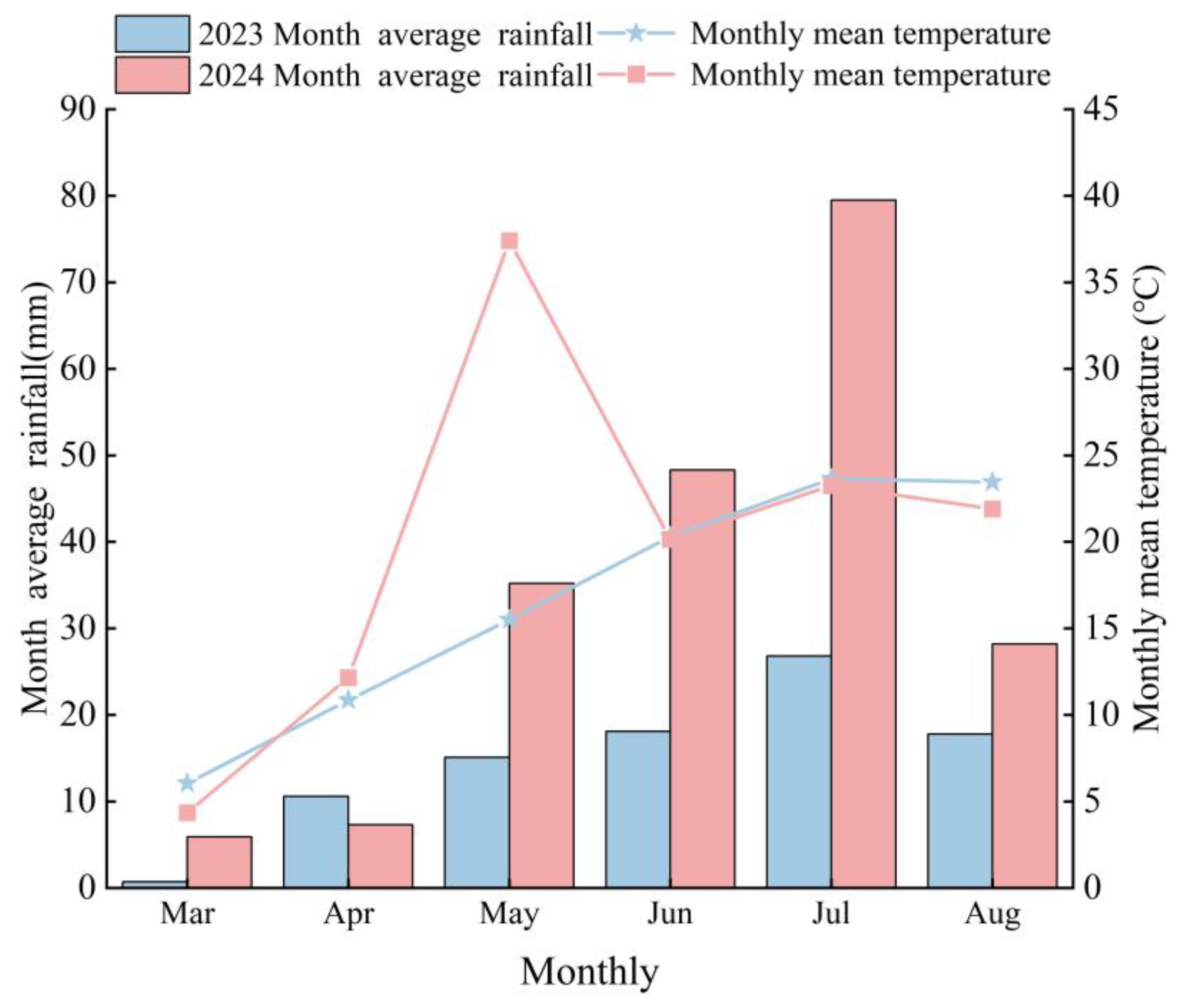
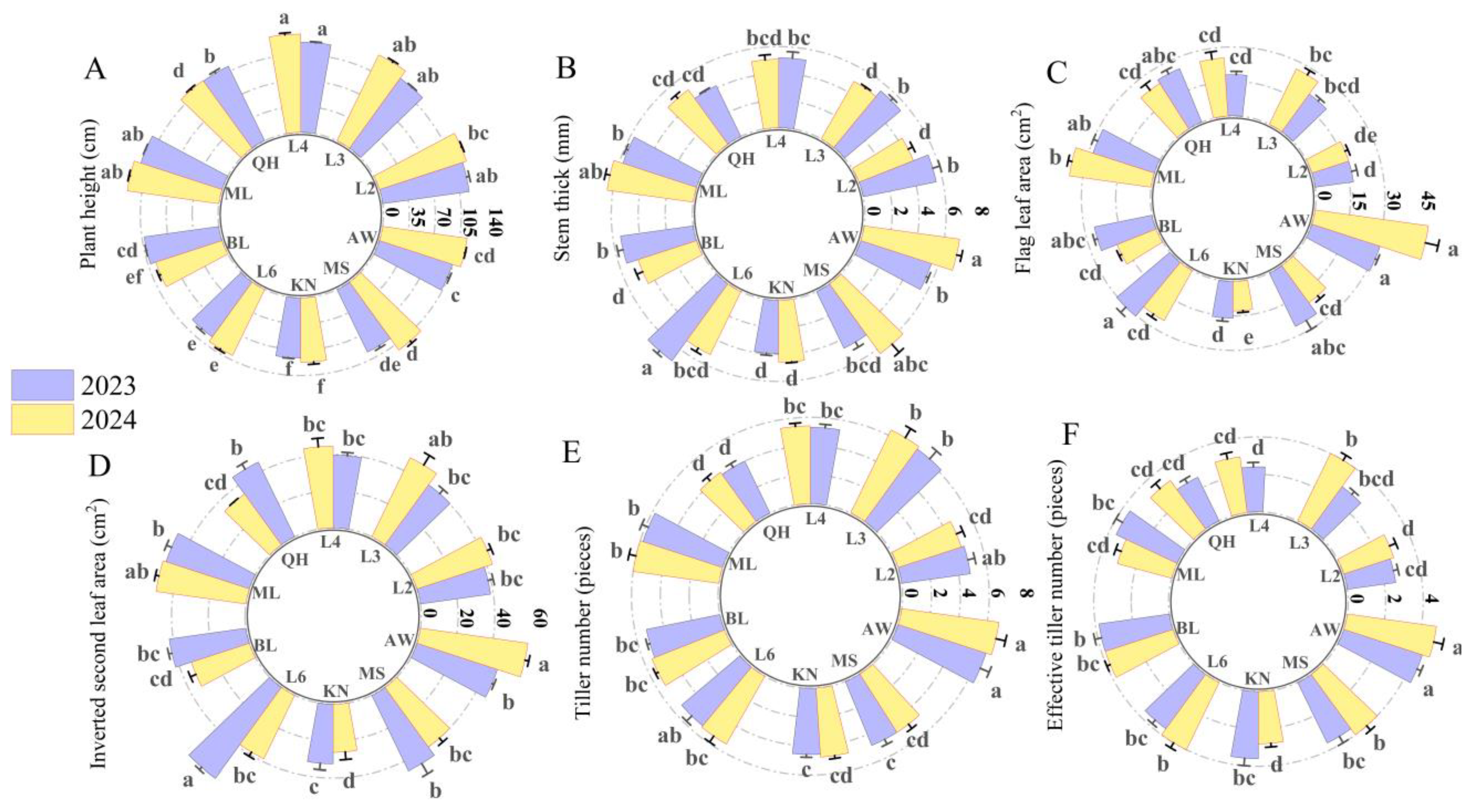
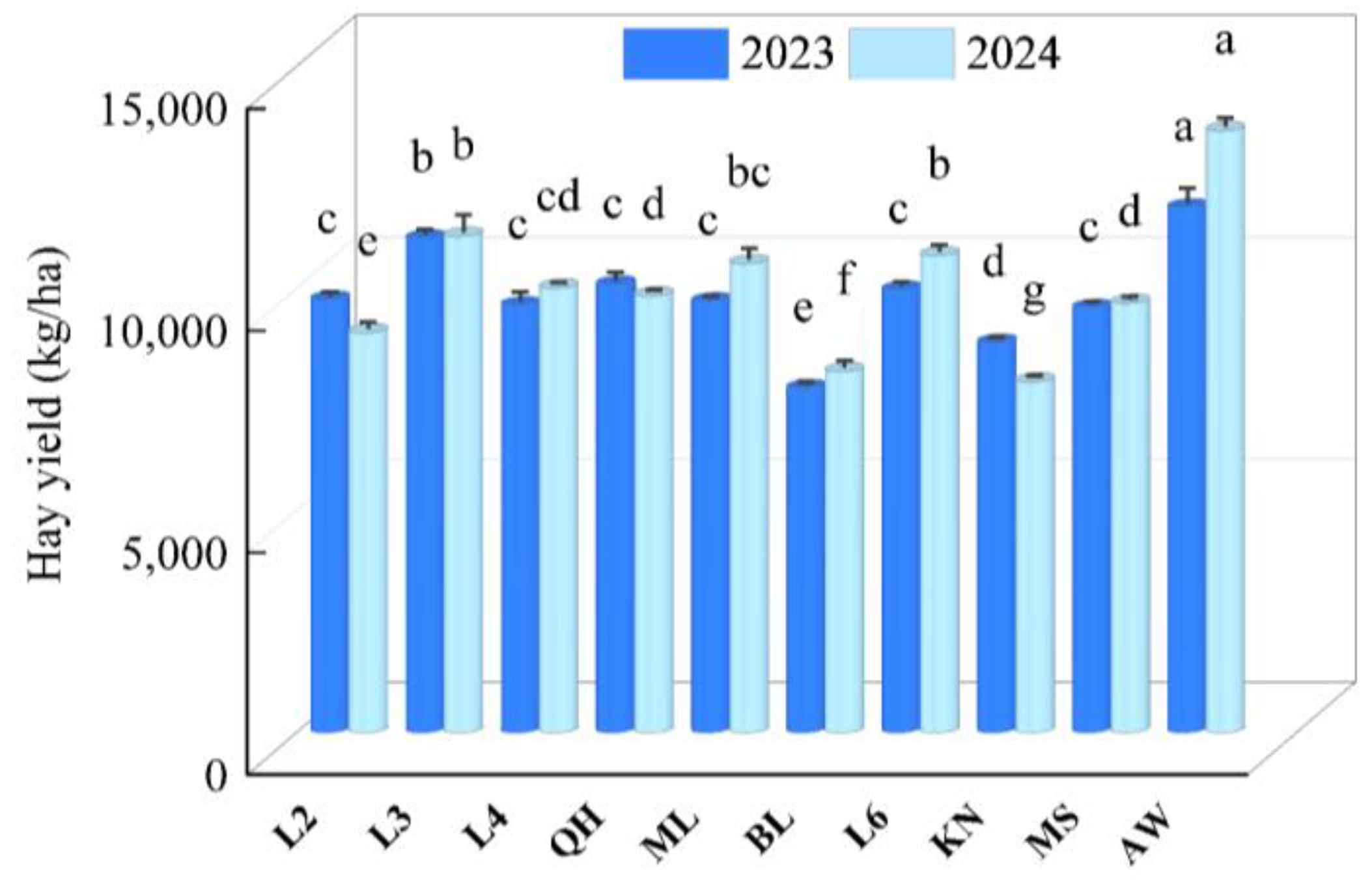
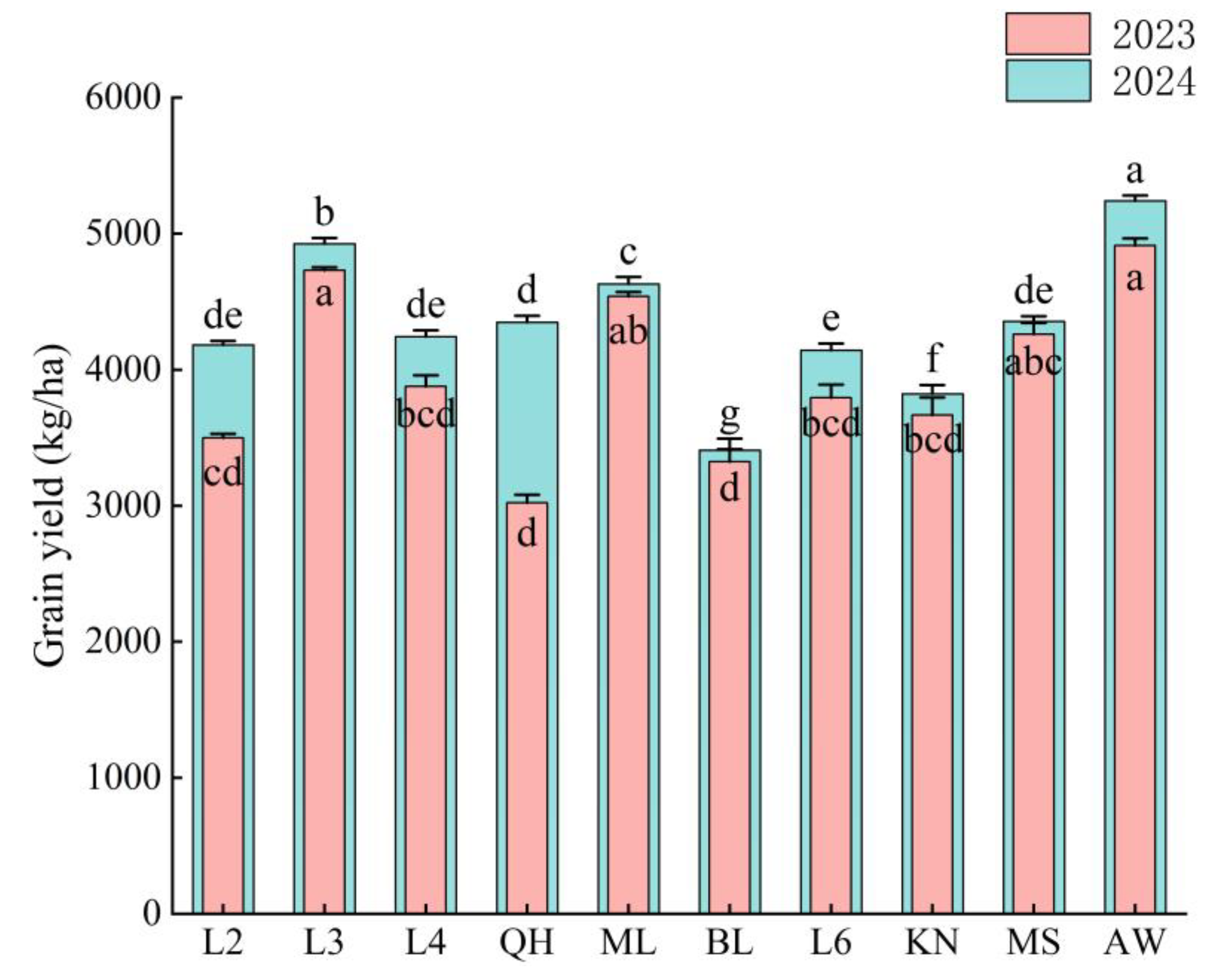

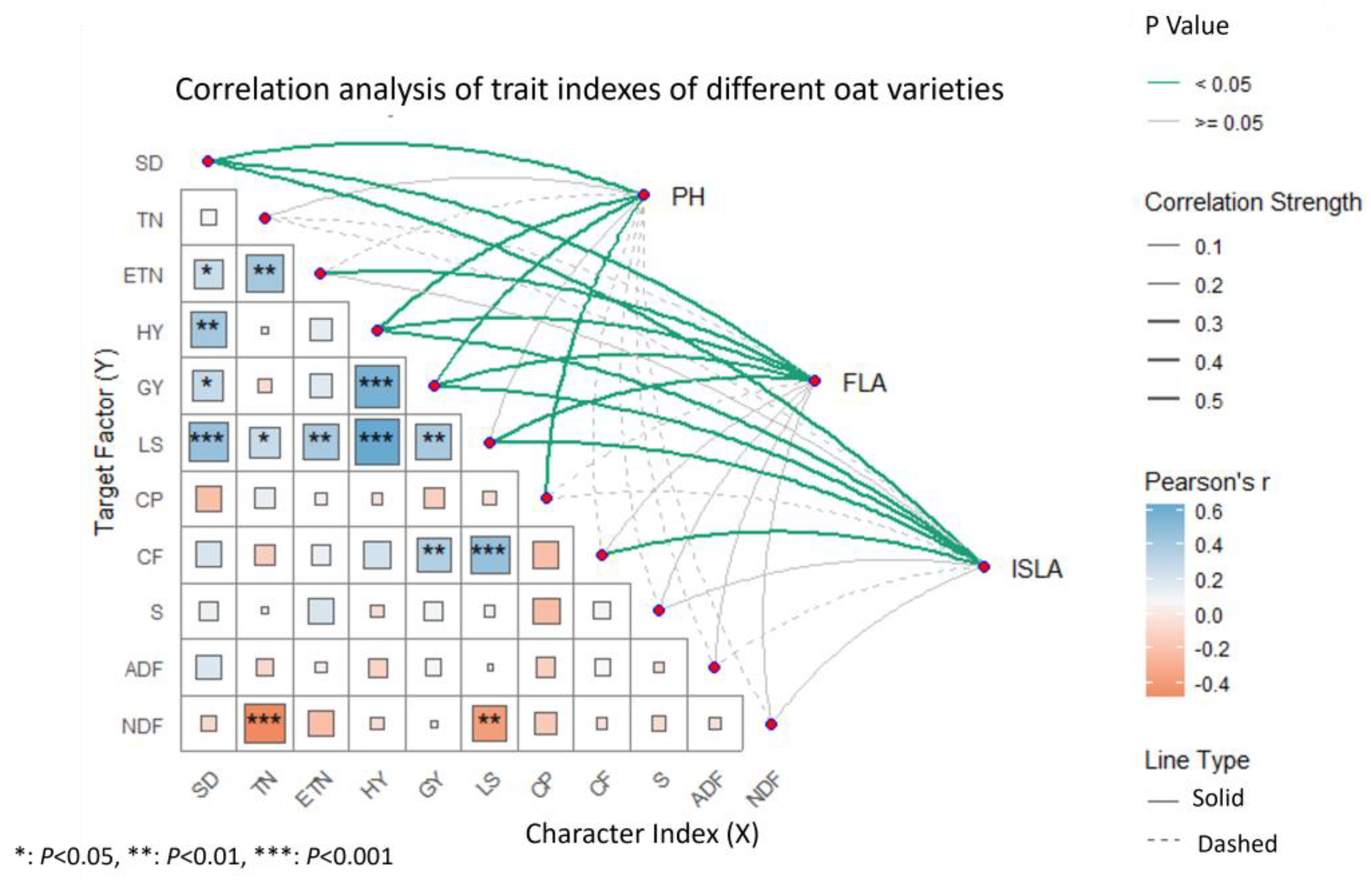
| Soil Nutrient | 2023 | 2024 |
|---|---|---|
| Organic matter | 27.15 g/kg | 28.56 g/kg |
| Organic carbon | 16.12 g/kg | 16.57 g/kg |
| Total phosphorus | 0.38 mg/kg | 0.39 mg/kg |
| Total nitrogen | 0.48 mg/kg | 0.5 mg/kg |
| pH | 8.12 | 8.23 |
| Number | Varieties | Source | Percentage of Germination (%) |
|---|---|---|---|
| 1 | Longyan No. 2 | Gansu | 78 |
| 2 | Longyan No. 3 | Gansu | 83 |
| 3 | Longyan No. 4 | Gansu | 94 |
| 4 | Qinghai 444 | Qinghai | 89 |
| 5 | Molasses | USA | 81 |
| 6 | Baler II | Canada | 66 |
| 7 | Longyan No. 6 | Gansu | 81 |
| 8 | Kona | USA | 78 |
| 9 | Mengshi | USA | 80 |
| 10 | Everleaf 126 | USA | 81 |
| Variety | 2023 | 2024 | ||||||||
|---|---|---|---|---|---|---|---|---|---|---|
| Sowing Date | Seeding Stage | Grain-Filling Stage | Ripe Stage | Growth Duration (d) | Sowing Date | Seeding Stage | Grain-Filling Stage | Ripe Stage | Growth Duration (d) | |
| Longyan No. 2 | 3/27 | 4/8 | 6/21 | 7/13 | 97 | 3/27 | 4/7 | 6/23 | 7/15 | 99 |
| Longyan No. 3 | 3/27 | 4/10 | 6/23 | 7/18 | 100 | 3/27 | 4/8 | 6/25 | 7/21 | 104 |
| Longyan No. 4 | 3/27 | 4/10 | 6/22 | 7/14 | 96 | 3/27 | 4/7 | 6/23 | 7/16 | 100 |
| Qinghai 444 | 3/27 | 4/7 | 6/16 | 7/9 | 94 | 3/27 | 4/6 | 6/18 | 7/11 | 98 |
| Molasses | 3/27 | 4/7 | 6/24 | 7/16 | 101 | 3/27 | 4/8 | 6/24 | 7/22 | 105 |
| Baler II | 3/27 | 4/6 | 6/20 | 7/12 | 97 | 3/27 | 4/7 | 6/23 | 7/18 | 102 |
| Longyan No. 6 | 3/27 | 4/8 | 6/22 | 7/16 | 100 | 3/27 | 4/7 | 6/24 | 7/23 | 107 |
| Kona | 3/27 | 4/7 | 6/21 | 7/15 | 100 | 3/27 | 4/7 | 6/21 | 7/18 | 102 |
| Mengshi | 3/27 | 4/8 | 6/23 | 7/18 | 102 | 3/27 | 4/9 | 6/24 | 7/20 | 103 |
| Everleaf 126 | 3/27 | 4/10 | 6/28 | 7/30 | 111 | 3/27 | 4/10 | 6/29 | 8/1 | 113 |
| 2023 | 2024 | |||||||||||||||||
|---|---|---|---|---|---|---|---|---|---|---|---|---|---|---|---|---|---|---|
| Variety | Grade of Disease | Diseased Leaf Rate | Disease Index | Disease Resistance Types | Grade of Disease | Diseased Leaf Rate | Disease Index | Disease Resistance Types | ||||||||||
| 0 | 1 | 3 | 5 | 7 | 9 | 0 | 1 | 3 | 5 | 7 | 9 | |||||||
| Longyan No. 2 | 48 | 27 | 9 | 11 | 5 | 0 | 52 | 16.0 | MS | 42 | 32 | 16 | 8 | 2 | 0 | 58 | 14.8 | MR |
| Longyan No. 3 | 51 | 37 | 8 | 4 | 0 | 0 | 49 | 9.0 | MR | 50 | 35 | 10 | 4 | 1 | 0 | 50 | 10.2 | MR |
| Longyan No. 4 | 52 | 30 | 14 | 4 | 0 | 0 | 48 | 10.2 | MR | 44 | 28 | 15 | 10 | 3 | 0 | 56 | 16.0 | MS |
| Qinghai 444 | 53 | 18 | 11 | 18 | 0 | 0 | 47 | 15.7 | MS | 46 | 30 | 14 | 8 | 2 | 0 | 54 | 14.0 | MR |
| Molasses | 55 | 27 | 12 | 3 | 3 | 0 | 45 | 11.0 | MR | 51 | 34 | 9 | 4 | 2 | 0 | 49 | 10.5 | MR |
| Baler II | 53 | 21 | 16 | 10 | 0 | 0 | 47 | 13.2 | MS | 24 | 48 | 13 | 15 | 0 | 0 | 76 | 18.0 | MS |
| Longyan No. 6 | 44 | 33 | 21 | 2 | 0 | 0 | 56 | 11.7 | MR | 47 | 33 | 12 | 7 | 1 | 0 | 53 | 12.3 | MR |
| Kona | 29 | 43 | 14 | 14 | 0 | 0 | 71 | 17.2 | MS | 46 | 30 | 14 | 10 | 4 | 0 | 58 | 16.6 | MS |
| Mengshi | 50 | 35 | 9 | 6 | 0 | 0 | 50 | 10.2 | MR | 50 | 34 | 10 | 2 | 6 | 0 | 52 | 12.8 | MR |
| Everleaf 126 | 55 | 32 | 12 | 1 | 0 | 0 | 45 | 8.1 | MR | 53 | 32 | 11 | 4 | 0 | 0 | 47 | 9.40 | MR |
| 2023 | 2024 | |||||||||||||||
|---|---|---|---|---|---|---|---|---|---|---|---|---|---|---|---|---|
| Variety | Grade of Disease | Average Severity | Disease Resistance Types | Grade of Disease | Average Severity | Disease Resistance Types | ||||||||||
| 0 | 1 | 2 | 3 | 4 | 5 | 0 | 1 | 2 | 3 | 4 | 5 | |||||
| Longyan No. 2 | 30 | 30 | 20 | 10 | 10 | 0 | 1.40 | R | 40 | 30 | 16 | 14 | 0 | 0 | 1.04 | R |
| Longyan No. 3 | 30 | 30 | 13 | 2 | 5 | 0 | 0.82 | HR | 45 | 30 | 13 | 7 | 5 | 0 | 0.97 | HR |
| Longyan No. 4 | 36 | 30 | 17 | 11 | 6 | 0 | 1.21 | R | 50 | 18 | 16 | 9 | 7 | 0 | 1.05 | R |
| Qinghai 444 | 30 | 30 | 15 | 15 | 10 | 0 | 1.45 | R | 40 | 30 | 12 | 9 | 9 | 0 | 1.17 | R |
| Molasses | 55 | 30 | 12 | 3 | 0 | 0 | 0.63 | HR | 60 | 30 | 4 | 6 | 0 | 0 | 0.56 | HR |
| Baler II | 32 | 30 | 20 | 14 | 4 | 0 | 1.28 | R | 30 | 30 | 28 | 10 | 2 | 0 | 1.24 | R |
| Longyan No. 6 | 49 | 30 | 13 | 8 | 0 | 0 | 0.80 | HR | 60 | 25 | 10 | 5 | 0 | 0 | 0.60 | HR |
| Kona | 37 | 30 | 20 | 10 | 3 | 0 | 1.12 | R | 45 | 20 | 13 | 17 | 5 | 0 | 1.17 | R |
| Mengshi | 40 | 30 | 17 | 8 | 5 | 0 | 1.08 | R | 50 | 30 | 8 | 12 | 0 | 0 | 0.82 | HR |
| Everleaf 126 | 50 | 35 | 10 | 5 | 0 | 0 | 0.70 | HR | 55 | 26 | 11 | 8 | 0 | 0 | 0.72 | HR |
| 2023 | 2024 | |||||||||||||||
|---|---|---|---|---|---|---|---|---|---|---|---|---|---|---|---|---|
| Variety | Grade of Disease | Diseased Leaf Rate | Disease Index | Disease Resistance Types | Grade of Disease | Diseased Leaf Rate | Disease Index | Disease Resistance Types | ||||||||
| 0 | 1 | 2 | 3 | 4 | 0 | 1 | 2 | 3 | 4 | |||||||
| Longyan No. 2 | 38 | 42 | 20 | 0 | 0 | 62 | 20.5 | MR | 32 | 35 | 33 | 0 | 0 | 68 | 25.3 | MS |
| Longyan No. 3 | 54 | 36 | 10 | 0 | 0 | 46 | 14.0 | MR | 52 | 38 | 10 | 0 | 0 | 48 | 15.0 | MR |
| Longyan No. 4 | 41 | 34 | 25 | 0 | 0 | 59 | 21.0 | MR | 46 | 36 | 18 | 0 | 0 | 54 | 18.0 | MR |
| Qinghai 444 | 44 | 23 | 15 | 10 | 8 | 56 | 28.75 | MS | 47 | 16 | 21 | 16 | 0 | 53 | 26.5 | MS |
| Molasses | 51 | 37 | 12 | 0 | 0 | 49 | 15.3 | MR | 47 | 34 | 15 | 4 | 0 | 53 | 19.0 | MR |
| Baler II | 40 | 18 | 20 | 22 | 0 | 60 | 31.0 | MS | 34 | 42 | 21 | 3 | 0 | 66 | 20.0 | MR |
| Longyan No. 6 | 48 | 40 | 8 | 4 | 0 | 52 | 17.0 | MR | 42 | 37 | 16 | 5 | 0 | 58 | 21.0 | MR |
| Kona | 59 | 9 | 11 | 11 | 10 | 41 | 26.0 | MS | 40 | 33 | 17 | 7 | 3 | 60 | 25.0 | MS |
| Mengshi | 40 | 45 | 15 | 3 | 0 | 63 | 21.0 | MR | 40 | 36 | 24 | 0 | 0 | 65 | 21.0 | MR |
| Everleaf 126 | 55 | 36 | 9 | 0 | 0 | 45 | 13.5 | MR | 56 | 39 | 10 | 0 | 0 | 54 | 14.0 | MR |
| 2023 | 2024 | |||
|---|---|---|---|---|
| Variety | I/I * | Resistance Level | I/I * | Resistance Level |
| Longyan No. 2 | 1.16 | S | 1.14 | S |
| Longyan No. 3 | 1.06 | R | 1.03 | R |
| Longyan No. 4 | 1.18 | S | 1.15 | S |
| Qinghai 444 | 1.15 | S | 1.17 | S |
| Molasses | 1.18 | S | 1.08 | R |
| Baler II | 1.11 | S | 1.21 | HS |
| Longyan No. 6 | 1.15 | S | 1.09 | R |
| Kona | 1.21 | HS | 1.20 | S |
| Mengshi | 1.08 | R | 1.09 | R |
| Everleaf 126 | 1.02 | R | 1.05 | R |
| Variety | Principal Component 1 | Principal Component 2 | Principal Component 3 | Principal Component 4 | U(X1) | U(X2) | U(X3) | U(X4) | D Values | Rank |
|---|---|---|---|---|---|---|---|---|---|---|
| Longyan No. 2 | −0.80 | −0.97 | 0.66 | −0.10 | 0.18 | 0.07 | 0.65 | 0.48 | 0.24 | 9 |
| Longyan No. 3 | 1.08 | −1.12 | −0.49 | −0.69 | 0.80 | 0.02 | 0.27 | 0.31 | 0.53 | 3 |
| Longyan No. 4 | −0.49 | −1.17 | 0.29 | 0.05 | 0.28 | 0.00 | 0.52 | 0.52 | 0.28 | 8 |
| Qinghai 444 | −0.98 | −0.40 | 0.40 | 1.65 | 0.12 | 0.26 | 0.56 | 1.00 | 0.29 | 7 |
| Molasses | 1.70 | 0.12 | −1.31 | 0.64 | 1.00 | 0.43 | 0.00 | 0.70 | 0.73 | 2 |
| Baler II | −0.60 | 0.81 | −0.88 | 1.08 | 0.25 | 0.66 | 0.14 | 0.83 | 0.38 | 6 |
| Longyan No. 6 | 0.54 | −0.40 | 1.12 | −1.10 | 0.62 | 0.26 | 0.80 | 0.18 | 0.54 | 4 |
| Kona | −1.36 | 1.06 | −1.08 | −1.72 | 0.00 | 0.75 | 0.08 | 0.00 | 0.17 | 10 |
| Mengshi | 0.17 | 0.25 | −0.44 | 0.04 | 0.50 | 0.47 | 0.28 | 0.52 | 0.47 | 5 |
| Everleaf 126 | 0.75 | 1.81 | 1.73 | 0.14 | 0.69 | 1.00 | 1.00 | 0.55 | 0.78 | 1 |
| Weight | 0.57 | 0.21 | 0.12 | 0.1 |
| Variety | Principal Component 1 | Principal Component 2 | Principal Component 3 | U(X1) | U(X2) | U(X3) | D Values | Rank |
|---|---|---|---|---|---|---|---|---|
| Longyan No. 2 | −0.69 | −1.24 | −0.51 | 0.19 | 0.00 | 0.24 | 0.17 | 9 |
| Longyan No. 3 | 0.78 | −0.75 | −0.35 | 0.63 | 0.18 | 0.29 | 0.54 | 3 |
| Longyan No. 4 | −0.09 | −0.84 | −0.96 | 0.37 | 0.15 | 0.10 | 0.32 | 6 |
| Qinghai 444 | −0.78 | −1.22 | 1.93 | 0.16 | 0.01 | 1.00 | 0.21 | 8 |
| Molasses | 0.28 | 1.23 | 0.87 | 0.48 | 0.92 | 0.67 | 0.56 | 2 |
| Baler II | −0.97 | 1.46 | −0.68 | 0.11 | 1.00 | 0.19 | 0.24 | 7 |
| Longyan No. 6 | 0.69 | −0.26 | −1.28 | 0.60 | 0.36 | 0.00 | 0.52 | 4 |
| Kona | −1.32 | 0.55 | 0.39 | 0.00 | 0.66 | 0.52 | 0.13 | 10 |
| Mengshi | 0.09 | 0.76 | −0.33 | 0.42 | 0.74 | 0.29 | 0.46 | 5 |
| Everleaf 126 | 2.01 | 0.31 | 0.93 | 1.00 | 0.57 | 0.69 | 0.72 | 1 |
| Weight | 0.78 | 0.14 | 0.08 |
Disclaimer/Publisher’s Note: The statements, opinions and data contained in all publications are solely those of the individual author(s) and contributor(s) and not of MDPI and/or the editor(s). MDPI and/or the editor(s) disclaim responsibility for any injury to people or property resulting from any ideas, methods, instructions or products referred to in the content. |
© 2025 by the authors. Licensee MDPI, Basel, Switzerland. This article is an open access article distributed under the terms and conditions of the Creative Commons Attribution (CC BY) license (https://creativecommons.org/licenses/by/4.0/).
Share and Cite
Zhang, G.; Chai, J.; Zhao, G.; Zeng, L.; Wang, W.; Niu, K. Comprehensive Evaluation of Different Oat Varieties in Semi-Arid Areas of Gansu Province. Agronomy 2025, 15, 707. https://doi.org/10.3390/agronomy15030707
Zhang G, Chai J, Zhao G, Zeng L, Wang W, Niu K. Comprehensive Evaluation of Different Oat Varieties in Semi-Arid Areas of Gansu Province. Agronomy. 2025; 15(3):707. https://doi.org/10.3390/agronomy15030707
Chicago/Turabian StyleZhang, Guanlu, Jikuan Chai, Guiqin Zhao, Liang Zeng, Wenping Wang, and Kuiju Niu. 2025. "Comprehensive Evaluation of Different Oat Varieties in Semi-Arid Areas of Gansu Province" Agronomy 15, no. 3: 707. https://doi.org/10.3390/agronomy15030707
APA StyleZhang, G., Chai, J., Zhao, G., Zeng, L., Wang, W., & Niu, K. (2025). Comprehensive Evaluation of Different Oat Varieties in Semi-Arid Areas of Gansu Province. Agronomy, 15(3), 707. https://doi.org/10.3390/agronomy15030707








